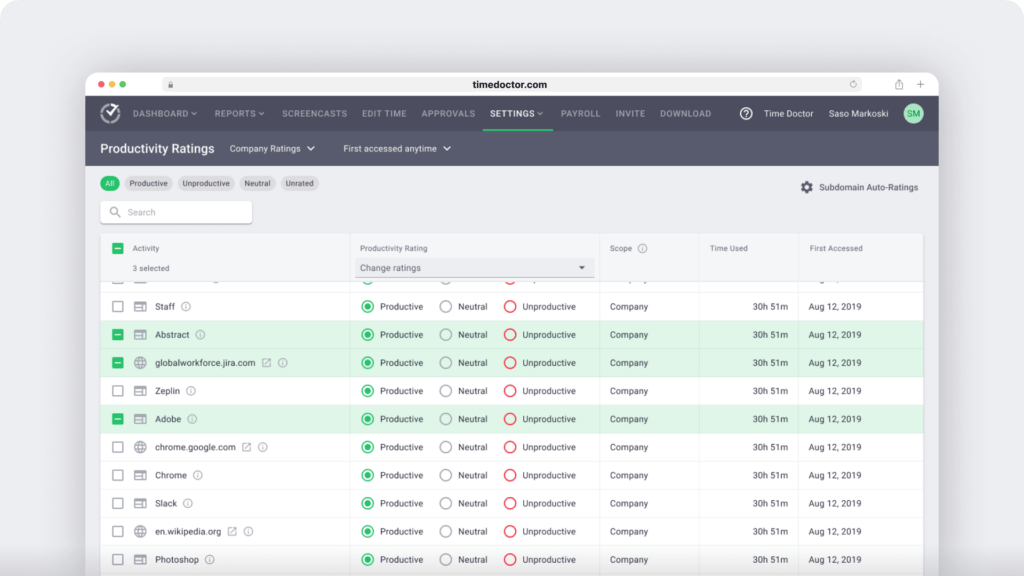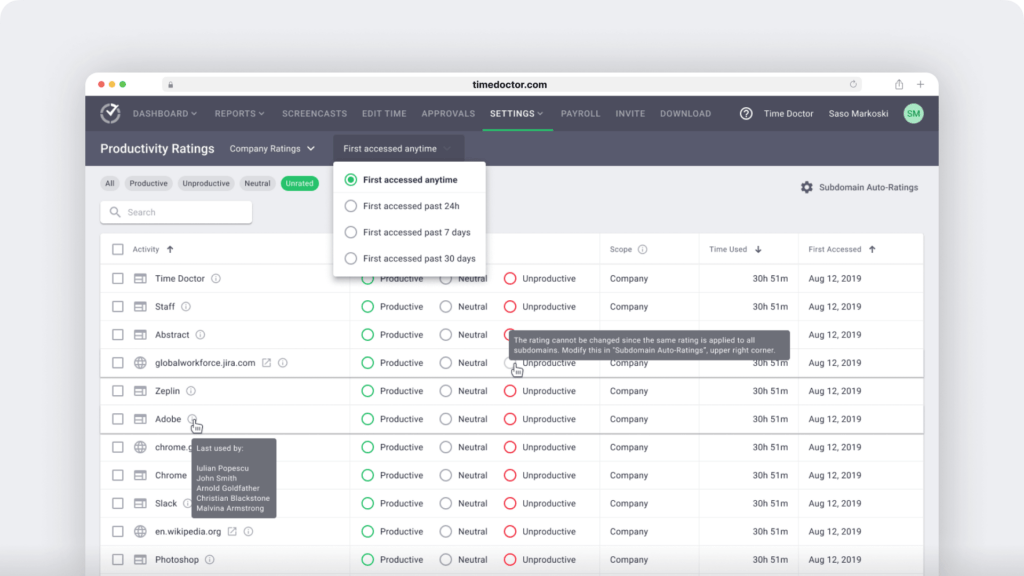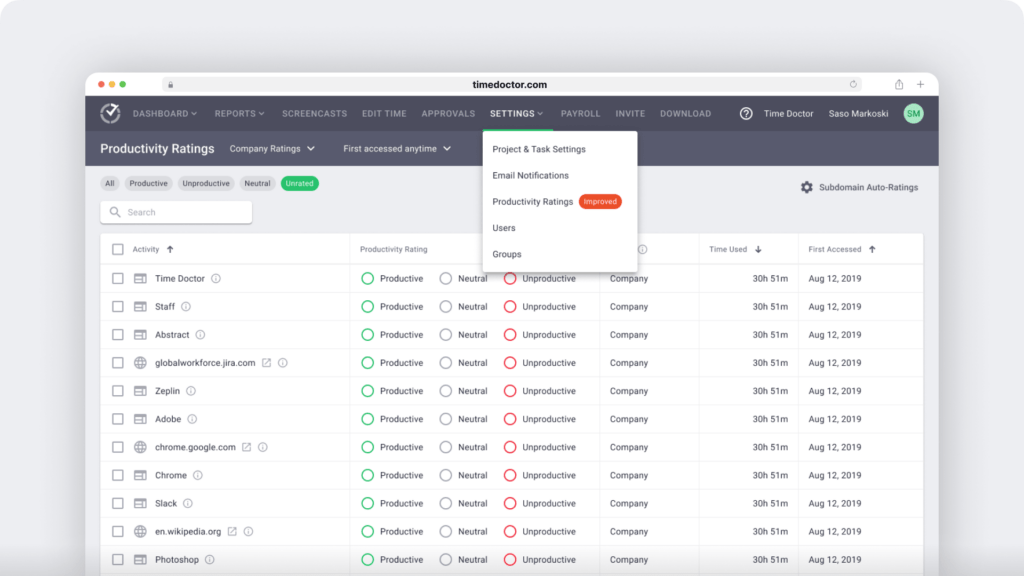Most people realize this too late: personalizing your Time Doctor Productivity Ratings is the secret to evaluating your team’s performance accurately and fairly.
Ratings put a value on the underlying software, channels, and information sources your team interacts with when delivering outputs and outcomes.
In addition to wisely spending time on tasks that matter—how work is produced is important for your company’s cost-effectiveness. Deciding the best tools and approaches to use is a fundamental time management skill for employees, and managers need to understand when people are floundering.
Fortunately, Time Doctor can help you understand your team’s workflows, tool selection, and efficiency to a nuanced degree—making it easier for you to refine processes, improve performance, optimize IT investments, and set performance benchmarks.
And it’s all underpinned by customized Productivity Ratings.
Get a clearer view of performance without extra oversight
On the surface, Productivity Ratings aren’t a flashy feature but they are necessary to accurately measure productivity. They classify the various websites and online applications used by your employees into categories that reflect their impact on productivity.

For instance, when you generate an Activity Summary report, evidence of time spent productively is drawn from your team’s online work via sites and apps rated ‘productive’.
Each website or app can have one of three ratings:
- Productive – Needed for the employee to perform their job well.
- Unproductive – Potential time-wasters and distractions.
- Neutral – Not unproductive, but not proven to support getting work done.
You also have the flexibility to define ratings for different tools either:
- Across all users within your organization;
- For a specific team or job type (based on groups set-up within Time Doctor); or
- Based on a specific individual’s workflow.
Perhaps you’ve taken a glance at the default ratings provided by Time Doctor and thought “They’ll do”.
Here are just three short examples of how that could hinder your people management:
- Leaving sites on ‘neutral’ that are critical to some people’s jobs unfairly limits what is tracked as productive time, which could lead to unnecessary interventions or lack of recognition for effort (which can breed disengagement).
- Leaving commonly used apps—like your CRM—as ‘productive’ for your whole team doesn’t account for time-wasting by users whose core work requires very few interactions with the tool. It could be helpful to re-categorize to neutral for roles where the employees’ productivity isn’t closely tied to the app.
- Leaving social media websites rated “unproductive” for the whole company when specific teams, like Marketing, maybe using them for tasks like managing advertising campaigns and posting company updates.
Our defaults are based on assumptions that may not hold true for your specific company or certain departments or individuals—meaning the metrics shown in your dashboards and reports will not be as rich as possible.
You can go so much deeper when you personalize Productivity Ratings.
What factors determine how companies change Productivity Ratings?

Which tools or online activities benefit your business will depend on your industry, customer base, work format, and business model.
We’ve seen companies get more value from Time Doctor by updating their ratings:
- Based on tech investments and associated processes: For example, if you’ve provided access to Asana to all employees for project management and expect all employees to share information and statuses in the platform. You might determine an optimal percentage of time that certain roles should be working within the tool (e.g., managers tracking project updates across multiple teams)—which you can validate by using the ‘Web & App Usage Report’.
- Based on workplace policies and values: You might rate LinkedIn as neutral in line with your social media policy, which allows employees to spend small amounts of time on the site to update their profiles and stay abreast of colleagues and career tips.
- Based on varying expectations for customer care: Perhaps a major client prefers regular video calls using Skype. If you want your team to accommodate such requests to keep clients happy, it’s important their Productivity Ratings for such tools reflect this.
- Based on changing trends and emerging tech: For instance, perhaps you’re keen for your marketing team to start using ChatGPT prompts to streamline content planning, but you’re less keen on your coders playing around with the AI tool.
- Based on an individual’s unique skill set or function: An obvious example is your social media manager/s who may legitimately need to spend the majority of their time in apps like Facebook and Twitter to add content and respond to comments. Another example could be a compliance manager or legal officer who may be the sole user of specialized tools or information portals.
4 things that happen when you finally adjust Productivity Ratings in Time Doctor
With customized Productivity Ratings you can improve:
- Day-to-day performance: You’ll have more confidence in metrics about productive time, as well as trends and top performers, that you can use daily to uplift performance.
- Ongoing feedback and development: You’ll gain a better understanding of essential tools to support streamlined workflows in different departments and roles. That lets you recognize and reward efficient behaviors, train people to use tools better where needed, maximize your software ROI, and encourage better adherence to processes.
- Goal-setting for continuous improvement: With a more accurate view of which websites & apps actually drive productivity in different teams and roles, you can set clear goals and benchmarks to rally your team to reach new highs.
- More accurate reports: With updated ratings, the top and low performers on your Team Dashboard get an accuracy boost, and reports like the Web & App Usage and the Activity Summary will reflect more meaningful data to make sure teams are working on the right tools and tasks.
How to update and make the most of Productivity Ratings?
Productivity Ratings are a performance management secret hidden in plain sight. We encourage all companies that use Time Doctor to customize their settings and find that the companies most committed to using employee monitoring to drive improvements always do.
Users with Admin or Owner level access can customize Productivity Ratings on the Settings / Productivity Ratings page within the web app. Managers can also be given permission to adjust these settings for their teams.
If none of this sounds familiar, make sure you have web & app tracking enabled for your company, under Company Settings.
We suggest you follow these steps:
- On your Company Settings page, give managers permission to edit productivity ratings (by default, managers don’t have that permission).
- Ask managers to review workflows for a better sense of the sites and apps fundamental to team workloads and any individual employee exceptions.
- Adjust default ratings or unrated sites and apps based on this initial review.
- Make it a habit to regularly review new ‘unrated’ sites used by your team, and update ratings for current sites to better capture evolving online workflows and expectations for different teams and individuals.

Regular adjustments to Productivity Ratings are important to account for:
- People changing teams, getting promoted, or having their responsibilities shift.
- New tools and processes being adopted in your team or in company-wide workflows.
- Individual outliers and unusual use cases for certain tools or apps.
Leaders need insights into how people spend their time—but also to zero in on the workflows and tools being used that actually enhance performance quality. Start paying attention to your Productivity Ratings in Time Doctor to get an edge.

Amy Owens is a product marketing enthusiast with a passion for writing content that communicates the features, values, and benefits of products.


